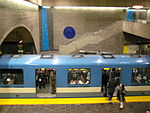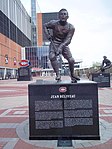Bank of Montreal National Historic Site

Bank of Montreal National Historic Site is an historic former bank branch in Montreal. Built in 1894 in sandstone on the corners of rue Notre Dame Ouest and rue des Seigneurs, this building was named a National Historic Site of Canada in 1990 because: the building is a particularly good example of the Queen Anne Revival style, as expressed in commercial architecture... Built for the bank of the same name, the Bank of Montréal building is a rare surviving example of the Queen Anne Revival style applied to a commercial building. Its use of Flemish motifs in imitation of a Flemish public building is typical of the style. The building is now home to Martha Franco Architecture and Design.
Excerpt from the Wikipedia article Bank of Montreal National Historic Site (License: CC BY-SA 3.0, Authors, Images).Bank of Montreal National Historic Site
Rue Notre-Dame Ouest, Montreal Le Sud-Ouest
Geographical coordinates (GPS) Address Nearby Places Show on map
Geographical coordinates (GPS)
| Latitude | Longitude |
|---|---|
| N 45.48781 ° | E -73.56869 ° |
Address
Les Démons de Notre-Dame
Rue Notre-Dame Ouest 1842
H3J 1M3 Montreal, Le Sud-Ouest
Quebec, Canada
Open on Google Maps









